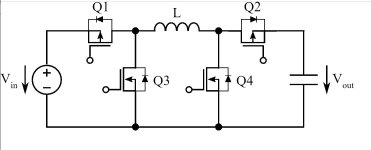ankanphukan
10 mW
- Joined
- Oct 1, 2021
- Messages
- 32
Hello everyone,
I need your help!!
I am designing a bidirectional dc dc converter. I am following the traditional bidirectional converter circuit with capacitors, inductor and MOSFETS. But I am facing a problem in that design.
As we all know, in the boost mode, one of the two mosfets acts like a diode; while the other mosfet behaves like a switch. Likewise, in the buck mode operation, exactly the opposite happens.
I tried to design and construct the boost converter and buck converter separately; i.e. I used one mosfet and one diode to realize both the converters separately. Both my designed converters are working perfectly fine, with an excellent efficiency.
Here, comes the main problem. As mentioned earlier, I want to design a bidirectional dc dc converter; i.e. both the boost converter and the buck converter must be in the same circuit. For this, I have to use two mosfets. But, whenever I connect both the mosfets as per circuit diagram, the converter doesn't work. It seems there is a tremendous voltage drop somewhere in the circuit.
Could anyone kindly help me solve this issue. I would be very grateful.
Kindly take out some time and help me out.
Thank you.
I need your help!!
I am designing a bidirectional dc dc converter. I am following the traditional bidirectional converter circuit with capacitors, inductor and MOSFETS. But I am facing a problem in that design.
As we all know, in the boost mode, one of the two mosfets acts like a diode; while the other mosfet behaves like a switch. Likewise, in the buck mode operation, exactly the opposite happens.
I tried to design and construct the boost converter and buck converter separately; i.e. I used one mosfet and one diode to realize both the converters separately. Both my designed converters are working perfectly fine, with an excellent efficiency.
Here, comes the main problem. As mentioned earlier, I want to design a bidirectional dc dc converter; i.e. both the boost converter and the buck converter must be in the same circuit. For this, I have to use two mosfets. But, whenever I connect both the mosfets as per circuit diagram, the converter doesn't work. It seems there is a tremendous voltage drop somewhere in the circuit.
Could anyone kindly help me solve this issue. I would be very grateful.
Kindly take out some time and help me out.
Thank you.



